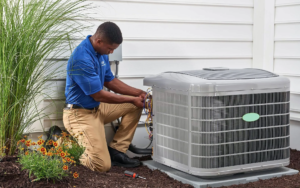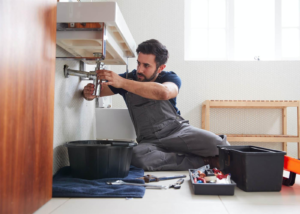Having an off-mains sewage system installed is often a complicated and confusing process. It is highly recommended that you have a professional carry out the installation and will guide you through the process.
A septic tank is buried underground and holds wastewater long enough for heavy solids to settle down to form sludge while oil, fats and grease float to the top and decompose. The septic tank then releases partially treated wastewater into the drain field. Check out Septic Tank Services Near Me for more information.
Site Survey and Soil Test

If you’re considering a septic tank installation for your home, or have one that needs replacing, you need to know the steps involved. This process includes soil evaluation and a site survey, which determines whether the proposed location will work well.
Homeowners should hire a licensed and insured professional to conduct the site survey. This step ensures the septic system will be located on their property, which could save them from expensive legal headaches down the road.
During the survey, a professional assesses the topography of the land and the setback requirements. They also take into account the soil composition, which determines how quickly wastewater will be absorbed and filtered by the ground. If the soil is too sandy, for example, it will not be able to absorb the water as quickly as clay-based soil.
The soil survey will also include a perc test, which analyzes the site’s drainage and soil. The results will indicate whether the site is suitable for a septic tank and will inform the design of the system. If the site fails the perc test, homeowners can explore alternative solutions such as groundwater drainage systems or trucking in engineered fill dirt.
A septic tank is a large underground container that receives all the wastewater from a household, including sinks, toilets, and drains. Solid waste settles at the bottom of the tank, while the liquid waste rises to the surface. The liquid is then filtered and dispersed into the surrounding soil through a drain field consisting of perforated pipes buried in gravel trenches.
There are different types of septic tanks, and the most common type is made from polyethylene or fiberglass. However, some people use concrete septic tanks, which are usually more expensive. Homeowners should discuss the various options with their septic installer before choosing the tank size and type.
When hiring a septic installer, homeowners should choose someone with experience and a strong track record in the industry. A reputable installer will provide detailed proposals and answer questions clearly. They should also have a reliable fleet of equipment, including excavators and backhoes.
Digging
If your home isn’t connected to the mains sewerage system, it will need its own waste disposal system. This is where septic tanks come in – these are underground chambers that help treat wastewater from household plumbing by combining settling and natural bacterial digestion processes. This process reduces solid waste, leaving only liquid sewage that passes through to the drain field for further treatment.
Before work can begin, the septic tank site needs to be carefully chosen and cleared. This involves focusing on space requirements, making sure the area is accessible for future maintenance and repairs and that it meets any local regulations and guidelines.
Once the location has been settled upon, a drainage pit is dug. The size of this excavation depends on the type of septic tank being installed. Generally, a reinforced concrete septic tank requires a larger hole than plastic or fiberglass ones. During this process, it’s important to take into account any obstructions that may be present on the property such as trees or structures. These will need to be either avoided or removed if possible to avoid damaging the septic tank or its pipes.
During the excavation, it’s also a good idea to use the opportunity to install any necessary risers or inlet and outlet tees for the tank. This is especially important if your septic tank is being built on bedrock or another material that would require special considerations during construction.
When the digging is complete, the septic tank is then lowered into the hole. Once it’s in place, the excavation site should be backfilled and compacted. It’s a good idea to use a specialised soil that is free of large rocks and other debris to minimise settling and ensure the tank remains stable.
If you’re planning to install a septic tank, working with a qualified professional is the best way to go. A specialist contractor like Superior Plumbing has the knowledge and experience to ensure that your new off-mains sewage system is not only efficient but also durable and compliant. Their expertise will also save you time and money in the long run.
Connecting the Tank to the Plumbing System
When buying a country property, you may dream of the quiet and space that comes with living on a rural area. But when you consider a home that requires a septic system, you might be concerned about the cost and work involved in maintaining one of these unique waste disposal systems. But installing a septic tank can save you money and time, as well as reduce the amount of sewage waste that ends up in your backyard.
The first step in septic tank installation is to locate the drain line from your house. You will need to dig down until you find this line, which is usually a 4-inch pipe. Ideally, this should run directly to your septic tank.
Once this is done, you can start digging the hole for your septic tank. This is a large hole, and it will require a backhoe or excavator to dig. When the hole is dug, it should be sloped and graded correctly so that wastewater will flow easily to your septic tank.
Next, you will need to connect the septic tank to your plumbing. This is a job for a plumber, and it will be very important to ensure that all the connections are made properly to avoid problems later on. The best way to do this is to have the pipes as straight as possible, and to use long radius bends where necessary. This will prevent turbulence inside the tank and minimize the chance of leaking or damage.
You will also want to make sure that the septic tank inlet and outlet are clearly marked. This can help you remember to keep it pumped and maintained, which is essential for a long-lasting septic tank. Risers should be installed over both the inlet and outlet of the septic tank to provide access for maintenance.
It is also a good idea to have a sign posted at the tank site that reminds you to call a professional plumber for regular septic tank pumping and inspection. These steps will help to maintain the function and longevity of your septic tank, and you can avoid expensive repairs by being diligent in these efforts.
Drain Field Installation
A septic system is designed to treat and dispose of household wastewater on-site rather than sending it to a central municipal sewer treatment plant. The system consists of two parts: the tank and the drain field.
The septic tank is a large, underground container made of concrete, fiberglass or polyethylene. The wastewater flows into the tank through a pipe. Solids settle to the bottom forming sludge, while oil and grease float to the top as scum. Compartments and a T-shaped outlet prevent the sludge and scum from exiting the tank, where they would travel into the drainfield area and pollute groundwater. The liquid wastewater (effluent) exits the tank through a system of perforated pipes and enters the drainfield area, where it’s absorbed by soil. The drain field is also a great place for microbes to filter and digest contaminants in the wastewater before it enters groundwater.
If a septic system is not properly installed and maintained, it can result in environmental contamination. Untreated sewage can infiltrate and pollute nearby waterways, contaminating freshwater with phosphorus and nitrogen. This pollution can have a negative impact on wildlife and human health.
After the septic tank is in place, it must be inspected for any cracks or damage. After inspection, it must be sealed to ensure it is watertight. The contractor may then backfill around the tank and add a layer of gravel to protect it from vehicle traffic or heavy equipment.
It’s important to maintain proper septic tank maintenance to avoid costly repairs and keep your family healthy. To help your septic tank and drain field last longer, use less water, especially in high-use areas such as the kitchen and laundry rooms. Water-efficient fixtures and appliances are another easy way to reduce the strain on your septic system. You should also not park or drive vehicles over the septic tank or drain field and avoid planting trees or shrubs too close to the pipes, as their roots can grow into the pipes and cause clogs.
Finally, be sure to use a pest control program that kills mosquitoes and other insects, as these can carry diseases such as hepatitis B and cholera. It’s also a good idea to map out the location of the septic tank and other system components with a marker or put up a sign, so you know where to locate them when doing home maintenance or yard work.

